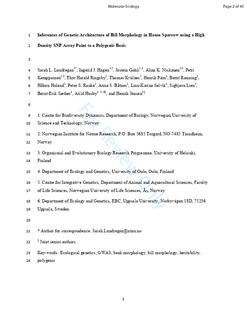| dc.contributor.author | Lundregan, Sarah | |
| dc.contributor.author | Hagen, Ingerid Julie | |
| dc.contributor.author | Gohli, Jostein | |
| dc.contributor.author | Niskanen, Alina Katariina | |
| dc.contributor.author | Kemppainen, Petri | |
| dc.contributor.author | Ringsby, Thor Harald | |
| dc.contributor.author | Kvalnes, Thomas | |
| dc.contributor.author | Pärn, Henrik | |
| dc.contributor.author | Rønning, Bernt | |
| dc.contributor.author | Holand, Håkon | |
| dc.contributor.author | Ranke, Peter Sjolte | |
| dc.contributor.author | Båtnes, Anna Solvang | |
| dc.contributor.author | Selvik, Linn-Karina M. | |
| dc.contributor.author | Lien, Sigbjørn | |
| dc.contributor.author | Sæther, Bernt-Erik | |
| dc.contributor.author | Husby, Arild | |
| dc.contributor.author | Jensen, Henrik | |
| dc.date.accessioned | 2019-04-26T13:52:53Z | |
| dc.date.available | 2019-04-26T13:52:53Z | |
| dc.date.created | 2018-07-04T22:17:02Z | |
| dc.date.issued | 2018 | |
| dc.identifier.citation | Molecular Ecology. 2018, 27 (17), 3498-3514. | nb_NO |
| dc.identifier.issn | 0962-1083 | |
| dc.identifier.uri | http://hdl.handle.net/11250/2595770 | |
| dc.description.abstract | Understanding the genetic architecture of quantitative traits can provide insights into the mechanisms driving phenotypic evolution. Bill morphology is an ecologically important and phenotypically variable trait, which is highly heritable and closely linked to individual fitness. Thus, bill morphology traits are suitable candidates for gene mapping analyses. Previous studies have revealed several genes that may influence bill morphology, but the similarity of gene and allele effects between species and populations is unknown. Here, we develop a custom 200K SNP array and use it to examine the genetic basis of bill morphology in 1857 house sparrow individuals from a large‐scale, island metapopulation off the coast of Northern Norway. We found high genomic heritabilities for bill depth and length, which were comparable with previous pedigree estimates. Candidate gene and genomewide association analyses yielded six significant loci, four of which have previously been associated with craniofacial development. Three of these loci are involved in bone morphogenic protein (BMP) signalling, suggesting a role for BMP genes in regulating bill morphology. However, these loci individually explain a small amount of variance. In combination with results from genome partitioning analyses, this indicates that bill morphology is a polygenic trait. Any studies of eco‐evolutionary processes in bill morphology are therefore dependent on methods that can accommodate polygenic inheritance of the phenotype and molecular‐scale evolution of genetic architecture. | nb_NO |
| dc.language.iso | eng | nb_NO |
| dc.publisher | Wiley | nb_NO |
| dc.title | Inferences of genetic architecture of bill morphology in house sparrow using a high-density SNP array point to a polygenic basis | nb_NO |
| dc.type | Journal article | nb_NO |
| dc.type | Peer reviewed | nb_NO |
| dc.description.version | acceptedVersion | nb_NO |
| dc.source.pagenumber | 3498-3514 | nb_NO |
| dc.source.volume | 27 | nb_NO |
| dc.source.journal | Molecular Ecology | nb_NO |
| dc.source.issue | 17 | nb_NO |
| dc.identifier.doi | 10.1111/mec.14811 | |
| dc.identifier.cristin | 1595743 | |
| dc.relation.project | Norges forskningsråd: 274930 | nb_NO |
| dc.relation.project | Norges forskningsråd: 223257 | nb_NO |
| dc.relation.project | Norges forskningsråd: 239974 | nb_NO |
| dc.relation.project | Norges forskningsråd: 221956 | nb_NO |
| dc.relation.project | Norges forskningsråd: 214553 | nb_NO |
| dc.description.localcode | Publisher embargo applies until July 24, 2019 | nb_NO |
| cristin.unitcode | 194,66,10,0 | |
| cristin.unitcode | 194,31,10,0 | |
| cristin.unitname | Institutt for biologi | |
| cristin.unitname | Institutt for naturhistorie | |
| cristin.ispublished | true | |
| cristin.fulltext | preprint | |
| cristin.qualitycode | 2 | |
